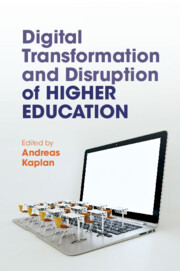Book contents
- Digital Transformation and Disruption of Higher Education
- Digital Transformation and Disruption of Higher Education
- Copyright page
- Contents
- Figures
- Tables
- Contributors
- Preface
- Chapter 1 Nothing Is Constant Except Change
- Part I (R)evolution of the Higher Education Sector
- Chapter 2 Higher Education’s Digitalisation
- Chapter 3 Online Learning
- Chapter 4 Social Exclusion and the Digital Divide
- Chapter 5 Internationalisation of Higher Education
- Chapter 6 Africa’s University Landscape
- Part II Changes in Teaching Formats
- Part III Changes in Teaching Content
- Part IV Networking and Social Activities
- Part V Certification and Diplomas
- Part VI Careers and Professionalisation
- Part VII Futuristic and Ultramodern Higher Education
- Part VIII Higher Education in Motion
- Editor’s Biography
- Index
- References
Chapter 3 - Online Learning
Expectations versus Reality
from Part I - (R)evolution of the Higher Education Sector
Published online by Cambridge University Press: 09 June 2022
- Digital Transformation and Disruption of Higher Education
- Digital Transformation and Disruption of Higher Education
- Copyright page
- Contents
- Figures
- Tables
- Contributors
- Preface
- Chapter 1 Nothing Is Constant Except Change
- Part I (R)evolution of the Higher Education Sector
- Chapter 2 Higher Education’s Digitalisation
- Chapter 3 Online Learning
- Chapter 4 Social Exclusion and the Digital Divide
- Chapter 5 Internationalisation of Higher Education
- Chapter 6 Africa’s University Landscape
- Part II Changes in Teaching Formats
- Part III Changes in Teaching Content
- Part IV Networking and Social Activities
- Part V Certification and Diplomas
- Part VI Careers and Professionalisation
- Part VII Futuristic and Ultramodern Higher Education
- Part VIII Higher Education in Motion
- Editor’s Biography
- Index
- References
Summary
The COVID-19 pandemic brought significant changes to student experiences. A sudden switch to an online learning mode may serve as a natural experiment for the educational system. In this chapter, we test four "promises" of online education, which were widely discussed before the pandemic. Based on survey data of 5,464 undergraduate students from eight Russian universities, we compare the expectations to the reality of online learning. As the results show, the massive forced transition to online learning gave students more time to sleep, but they are not less tired than in traditional educational formats. Students find it difficult to ask questions, focus their attention when an instructor delivers material and find a comfortable place for studying. Consequently, the majority of students estimate their learning as ineffective. Relying on these results, we formulate lessons learned from this natural experiment.
Keywords
- Type
- Chapter
- Information
- Publisher: Cambridge University PressPrint publication year: 2022



